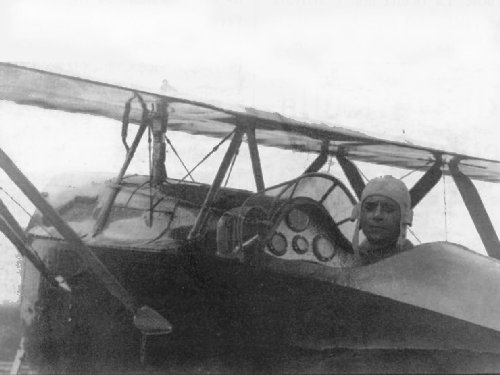|
Our co-citizen flyer
Memory of Luigi Mancini
By Angelo Balistieri |
ERROR CORRECTION
IIn reference to the article about the Pinewood, in the
“Amici
di Torricella” Number 13 of November 1992, written by Nicola Piccone.
Lucio Mancini has sent us a correction which we publish now and beg our
readers and all interested parties to forgive us for the involuntary
mistake:
“Luigi Mancini’s co-pilot, in the biplane that landed in Torricella
Peligna in 1922 for the inauguration of the Pinewood, was not the ace Di
Pinedo, but rather the ace De Bernardi – and it was Luigi Mancini
who personally flew the biplane. In the photo one can see Luigi Mancini
aboard his private plane, similar to, if not the same one in which he
landed at Torricella Peligna.”
(Lucio Mancini) |
Photo: Luigi Mancini aboard his aeroplane
 Those of us who knew Luigi Mancini believe that we recall the spontaneous
cordiality of his features, his easy, pressing eloquence and that pride, present
in his every action and every word, which was almost a part of his very
personality, of his having been a pilot since before the First World War, of
having dedicated the whole of his life to aviation, both actively and in the
aeronautic press. Luigi Mancini died early this September (Editor’s note: 1979)
aged 85 years; an age at which even the most vigorous need to use caution in
their movements; but he could not stay still. Even last June (Editor’s note:
1979), as he did every two years, he attended the Aerospace Exhibition in Paris,
the same as he always attended the biennial English Exhibition at Farnborough. Those of us who knew Luigi Mancini believe that we recall the spontaneous
cordiality of his features, his easy, pressing eloquence and that pride, present
in his every action and every word, which was almost a part of his very
personality, of his having been a pilot since before the First World War, of
having dedicated the whole of his life to aviation, both actively and in the
aeronautic press. Luigi Mancini died early this September (Editor’s note: 1979)
aged 85 years; an age at which even the most vigorous need to use caution in
their movements; but he could not stay still. Even last June (Editor’s note:
1979), as he did every two years, he attended the Aerospace Exhibition in Paris,
the same as he always attended the biennial English Exhibition at Farnborough.
Mancini began his career in aviation in 1914, when he went to the First Civil
School of Flight in Rome, and took part in 1915 in the Group of Voluntary
Aviators, with the Honourable Montù, at Mirafiori. As a War Pilot, he flew a
Caproni aircraft to one of the first attacks on enemy aircraft, using a rifle
he’d carried aboard, to try and hit the adversary’s aircraft. As a Fighter Pilot
he then faced up to many air battles for which his name was put forward for the
Silver and Bronze Medals for Military Valour.
After the War his passion for flying pushed him towards air competitions,
beating records and commercial air transport. For several years he was the
Editor in Rome of the “Gazetta dell’Aviazione” (The Aviation Gazette),; he
founded and directed the review “Aeronautica” (Aeronautics), “Orario Aereo” (Air
Hours), “Ali d’Italia” (Wings of Italy), apart from special numbers dedicated to
particular air-shows and manifestations etc. His last publication, that has been
out for a number of years now, and still being published at the time of his
death, was “La ruota diorama” (The Diorama Wheel).
There is one of Mancini’s publications that deserves special mention for various
reasons: first and foremost because it was truly an original work for the era in
which it was written, 1936; it is in fact the “Grande Enciclopedia Aeronautica”
(The Great Aeronautic Encyclopedia), a juge volume with 660 pages of text, and
innumerable illustrations. It might seem strange that Mancini’s Encyclopedia had
no further editions or periodic updates. This lack of continuity, according to
us, does not lie with the work itself, but can be attributed rather to something
curiously lacking in Mancini’s temperament; a profoundly independent spirit and
aware of his own capacities and accomplishments, he did not have one of the most
secure levers of success, that of being able to call for the support of the
powerful for own ideas. He did things himself and he cared about doing things
himself, almost like continually throwing himself a challenge.
It is also for this reason, apart from all the events in his life as an aviator,
that perhaps Luigi Mancini will not be remembered with spectacularly loud
cheers, but he will certainly remain within the centre of the hearts of those
who knew him. Finally, to those of us who were his colleagues and pupils, apart
from Mancini the pioneer of flight, of aeronautics, and of commercial air links,
we are deeply sorry not to be able to give a drawn-out description of the golden
human attributes of his personality, his modesty, his generosity and the
affectionate altruism which all made his sincere friendship an inestimable
treasure.
|